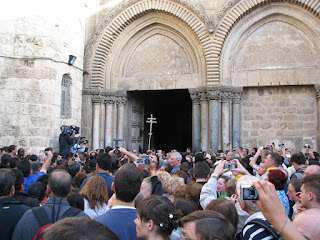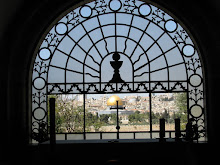Visiting Jerusalem is an opportunity of a lifetime to many. For me, to visit the Old City of Jerusalem was like a dream coming true. A city so much filled with history, sanctity and emotions that I doubt hardly there would be any other place in the world that could surpass Jerusalem's special and unique identity. However, as a city, Jerusalem never had any of the natural advantages. She was not situated on any major crossroads, or trade routes. Jerusalem had no natural harbour, no sea coast, nor any river and even had no major water supply. Yet it has been besieged 23 times; attacked an additional 52 times; captured and recaptured 44 times in a time span of 4000 years! Ironically, Jerusalem in Hebrew means “the City of Peace”! The capital city of Israel is spread in an area of 123 km2 with a population numbering 724,000. The Old City of Jerusalem comprising an area of 1 km2 is probably the holiest and the most contested religious site in this planet today. The word “Jerusalem” appears more than 800 times in Bible! Jerusalem with more than 1204 synagogues, 158 churches, and 73 mosques stands as a religious crossroad unlike any place in history. A city where more than 50 religions and denominations worship in 15 different languages with more than 400 holy sites! A city where three days in a week are holidays. The city invokes a lot of energy, expectations and mystery to many. There is even a psychological disorder characterized by religiously themed obsessive ideas and delusions triggered by a visit to the city called the Jerusalem syndrome!
The Abrahamic faith of 3.6 billion Jews, Christians and Muslims (55% of mankind) is derived from the events and personalities associated with this city and its vicinity. I think unlike many other old cities, what make Jerusalem very unique is its unpredictable nature and its extremely rich history blended with sacredness. Traditionally, the Old City has been divided into four quarters, the Muslim Quarter, the Christian Quarter, the Jewish Quarter and the Armenian Quarter. The city enshrines one of the holiest sites of the three monotheistic religions. Temple Mount and its Western Wall for Jews, the Church of the Holy Sepulchre for Christians, and the Dome of the Rock and al-Aqsa Mosque for Muslims. The city is surrounded by walls 4.5 kilometres long, 40 feet high, 10 feet thick and with 8 gates and 34 towers.
Mission Jerusalem began on a Thursday afternoon (20th March) with three Post Doctoral Researchers (originally from India, Italy and Nigeria). We took the egged 446 from Beer Sheva at 1.45 pm and reached Jerusalem central bus sation by 4.15 pm. From Jerusalem Central, we took the City Bus No 66 to the Old City (10 min drive). We entered the Old City through the Damascus gate and walked through the busy markets to the Hebron Youth Hostel, where we had to accommodate ourself for 3 days. The hostel was located at the very heart of the Old City, just near the Church of Holy Sepulcher. In the next 3 nights and 3 days we had an amazing experience through the places visited and the people we interacted.
An Arab who works in UN for Palestine welfare, whose father was a French Jewish Scholar (before converting to Islam) who claims to have saved thousands of Jews during holocaust; A once well placed mathematician who left everything she had just to become the care taker of a church and to proclaim the word of God; An old man with a donkey (he calls him Peter) who has 17 children from 2 wives, struggling to meet his ends meet by begging in street; A Muslim whose family holds the key to the holiest site of Christianity through generations are just some of the few extremes. Among the venues visited, the Good Friday mass attended at the Holy Sepulcher, the Armenian Mass at St. Jame’s Cathedral (One of the most beautiful and melodious I had experienced), the Malayalam mass at St. Marks Syrian Orthodox Church, the visits to the Dome of the Rock and the Western Wall were very special for me. Three days were nothing to see the complete Old City, but we were lucky enough to cover the prime destinations. As some one has put it right; every time you visit Jerusalem there is always a temptation to come back.At Sunday evening (23rd March) we took a taxi from the Damascus gate to Central Bus station and took Egged 470 to Beer Sheva at 5.30 pm. Reached Beer Sheva at 7.30 pm and took Metropolin 60 to Sde Boker. Back home by 9 pm.
The Abrahamic faith of 3.6 billion Jews, Christians and Muslims (55% of mankind) is derived from the events and personalities associated with this city and its vicinity. I think unlike many other old cities, what make Jerusalem very unique is its unpredictable nature and its extremely rich history blended with sacredness. Traditionally, the Old City has been divided into four quarters, the Muslim Quarter, the Christian Quarter, the Jewish Quarter and the Armenian Quarter. The city enshrines one of the holiest sites of the three monotheistic religions. Temple Mount and its Western Wall for Jews, the Church of the Holy Sepulchre for Christians, and the Dome of the Rock and al-Aqsa Mosque for Muslims. The city is surrounded by walls 4.5 kilometres long, 40 feet high, 10 feet thick and with 8 gates and 34 towers.
Mission Jerusalem began on a Thursday afternoon (20th March) with three Post Doctoral Researchers (originally from India, Italy and Nigeria). We took the egged 446 from Beer Sheva at 1.45 pm and reached Jerusalem central bus sation by 4.15 pm. From Jerusalem Central, we took the City Bus No 66 to the Old City (10 min drive). We entered the Old City through the Damascus gate and walked through the busy markets to the Hebron Youth Hostel, where we had to accommodate ourself for 3 days. The hostel was located at the very heart of the Old City, just near the Church of Holy Sepulcher. In the next 3 nights and 3 days we had an amazing experience through the places visited and the people we interacted.
An Arab who works in UN for Palestine welfare, whose father was a French Jewish Scholar (before converting to Islam) who claims to have saved thousands of Jews during holocaust; A once well placed mathematician who left everything she had just to become the care taker of a church and to proclaim the word of God; An old man with a donkey (he calls him Peter) who has 17 children from 2 wives, struggling to meet his ends meet by begging in street; A Muslim whose family holds the key to the holiest site of Christianity through generations are just some of the few extremes. Among the venues visited, the Good Friday mass attended at the Holy Sepulcher, the Armenian Mass at St. Jame’s Cathedral (One of the most beautiful and melodious I had experienced), the Malayalam mass at St. Marks Syrian Orthodox Church, the visits to the Dome of the Rock and the Western Wall were very special for me. Three days were nothing to see the complete Old City, but we were lucky enough to cover the prime destinations. As some one has put it right; every time you visit Jerusalem there is always a temptation to come back.At Sunday evening (23rd March) we took a taxi from the Damascus gate to Central Bus station and took Egged 470 to Beer Sheva at 5.30 pm. Reached Beer Sheva at 7.30 pm and took Metropolin 60 to Sde Boker. Back home by 9 pm.





































